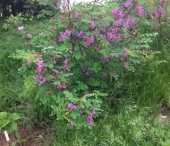posted 9 years ago
Hey all,
I thought I'd like to share parts of mine and my family's plans for this 60ish acre off-grid ranch. We're in a pretty arid grassland/ shrubby-steppe part of Northeast Oregon with very hot summers, and we can also get some brutally cold winters and there's usually late and early frosts. We'll get between 8 and 14 inches of rain per year but it's been on the very low end of that spectrum for some years now. We have goats, lowline angus cattle, chickens and turkeys, a couple horses, and turkish kangals (livestock guardian dogs). We're also setting up three orchard/tree spaces with annual and perennial veggie gardens in and around them. We're trying to make a balance where we can do our human stuff like feed ourselves while also improving upon this ecosystem.
Right now we have three major projects we're working on, and they're all tied together. 1: Better pasture management for our grazing animals. 2: Growing useful trees. 3: Riparian area restoration, particularly with the quickly-eroding creek which runs through a good portion of the property.
The pasture management plans include implementing rotational grazing (need money to get some more fencing in!) and adding other food sources to relieve dependence and stress on the pastures. We have a grain sprouting system which can produce over 140 pounds of fodder each day which provides nutrition for all of the animals during the winter months, leaving only their need for ruffage which can come from many sources.
The riparian area restoration, at this point, consists of adding as much woody debris as possible to fill up the creek, lift it from it's current path (it's busy making a little ravine since our soil is just layer after layer of volcanic ash), and nudging it away from the eroding banks. This last year has been the first time we've really been tackling that chore. There were a couple hundred western juniper trees all along the creek which I removed in the spring of 2015 because they're really terrible for this area. This year I've been placing debris (branches, small trees) along the eroding banks in such a way as to maximize the accumulation of gunk when the creek level rises during the winter and spring months. Lots of the willows, alders and birches are growing better without the junipers and I'll be planting loads more willows and hybrid poplars along the creek to further woody growth, shade the creek, and increase sources of debris. We'll also be using the riparian area for planting things like lindens, paw paws, locusts, hazelnuts, fruit trees of various sorts, witch hazel, berries, currants, etc. I'm planning on making some of that bone-tar stuff to keep deer and our goats away so I don't have to use up all our field fencing for the purpose of containing the new trees and shrubs like I'm currently doing, hahaha.
Then we have the tree and gardening projects. I want to grow a lot of pea trees (C. arborescens) as a major source of future ruffage for our animals. Thankfully they appreciate dry soils and do very well in a town nearby so I have high hopes for them. I also want to grow a lot of honey locusts and black locusts. The honey locusts can be for mainly for ruffage, shade and firewood, while the black locusts will mainly be for firewood and fence posts. We're interplanting with all sorts of other woody and perennial stuff, and until it all gets established those areas are also where our vegetable gardens are growing. Two of the tree-growing areas extend away from the creek into some pretty dry soil, so mulch has been a big help keeping moisture in, as well as being a major source of nutrients since our mulch is full of goat and chicken excrement.
Eventually I'd like to try making hedges with the locusts, hawthorn, and a spattering of other drought-tolerant species as a way to phase out barbed wire fencing in some areas, don't know when I'll be getting to that however.
I'm really excited to see how things progress in the gardens as summer comes in and the temps start rising. The honey locust and pea tree seedlings seem to be rocking it, so do the surrounding veggies, more of which will get planted a couple days from now because we're in a bit of a cold snap. One of the veggie areas has a misting/drip line system for watering, the other has many little canals and both systems seem to be working very well thus far. And the black locust root cuttings which i took and potted are sending up shoots now, so they're growing and will be planted in the ground next year!
One of my largest concerns has to do with the trees and perennials in the dry areas. Once the riparian area is more greatly expanded and getting healthier there'll be an easier time planting stuff but I worry that the trees in the dry spots will be dependent on my watering system compared to the trees in the riparian zone which don't need help once they get established. The honey locusts seem to be growing some monster taproots, same with the pea trees and paw paws, so that gives me hope but I think this will be something I'll have to play by ear and adjust as needed. There's certainly work with swales which I could do and that will help once I find the time to do it!
It's an awful lot of irons in the fire and so I'm trying to be as flexible as possible and work with the natural surroundings. It's just a lot to take in! And we were all so green when we started this lifestyle, this is the first year I feel like we're really getting a grip and busting out with productivity and a solid direction!
I'd be happy to hear any suggestions or questions anybody has, it seems like there's a wealth of knowledge and different perspectives which have all come together on this website so I'm all ears for anything from anyone. I'm happy to have circles of friendly people in my community and on places like here. After all, it takes a village!
I suppose I'll keep this thread updated as big progress with those three projects continues to be made! I'm probably most excited for the riparian area restoration, it's going to be so rad. Heck, it already is so rad!
Know thyself; Nothing in excess; Make a pledge and mischief is nigh.

 1
1








 1
1








 3
3









